display Alfa Romeo GT 2006 Owner handbook (in English)
[x] Cancel search | Manufacturer: ALFA ROMEO, Model Year: 2006, Model line: GT, Model: Alfa Romeo GT 2006Pages: 307, PDF Size: 6.05 MB
Page 139 of 307
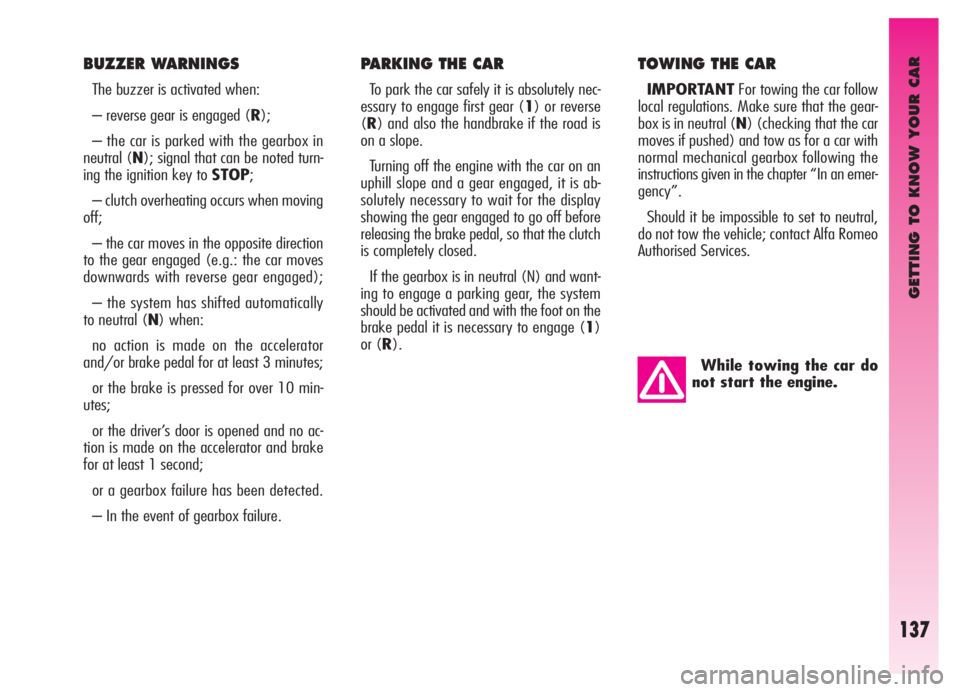
GETTING TO KNOW YOUR CAR
137
PARKING THE CAR
To park the car safely it is absolutely nec-
essary to engage first gear (1) or reverse
(R) and also the handbrake if the road is
on a slope.
Turning off the engine with the car on an
uphill slope and a gear engaged, it is ab-
solutely necessary to wait for the display
showing the gear engaged to go off before
releasing the brake pedal, so that the clutch
is completely closed.
If the gearbox is in neutral (N) and want-
ing to engage a parking gear, the system
should be activated and with the foot on the
brake pedal it is necessary to engage (1)
or (R).
TOWING THE CAR
IMPORTANTFor towing the car follow
local regulations. Make sure that the gear-
box is in neutral (N) (checking that the car
moves if pushed) and tow as for a car with
normal mechanical gearbox following the
instructions given in the chapter “In an emer-
gency”.
Should it be impossible to set to neutral,
do not tow the vehicle; contact Alfa Romeo
Authorised Services.
While towing the car do
not start the engine.
BUZZER WARNINGS
The buzzer is activated when:
– reverse gear is engaged (R);
– the car is parked with the gearbox in
neutral (N); signal that can be noted turn-
ing the ignition key to STOP;
– clutch overheating occurs when moving
off;
– the car moves in the opposite direction
to the gear engaged (e.g.: the car moves
downwards with reverse gear engaged);
– the system has shifted automatically
to neutral (N) when:
no action is made on the accelerator
and/or brake pedal for at least 3 minutes;
or the brake is pressed for over 10 min-
utes;
or the driver’s door is opened and no ac-
tion is made on the accelerator and brake
for at least 1 second;
or a gearbox failure has been detected.
– In the event of gearbox failure.
Page 147 of 307

GETTING TO KNOW YOUR CAR
145
OPENING FROM INSIDE
(fig. 143)
Tailgate is released electrically and this can
be performed only when the ignition key
is in position MARwith car at a standstill
or in STOPorPARKposition for 3 min-
utes without unlocking/locking one of the
doors.
To unlock the tailgate, press button (A)
on the centre console panel.
Tailgate raising is facilitated by the gas
shock springs.
OPENING WITH REMOTE
CONTROL
(fig. 144)
The tailgate can be opened by remote con-
trol from outside pressing the button (A),
also when the electronic alarm is engaged.
Opening of the tailgate is accompanied by
a double flash of the direction indicators;
closing is accompanied by a single flash.
If an electronic alarm is fitted, with the
opening of the tailgate, the alarm system
switches off volumetric protection and the
tailgate control sensor, the system “beeps”
twice (with the exception of certain mar-
kets).
Closing the tailgate again, the control func-
tions are restored, the system “beeps” twice
(with the exception of certain markets).
fig. 143
A0A0129b
LUGGAGE
COMPARTMENT
The tailgate can be opened:
from the outside of the car- by a
remote control impulse;
from the inside of the door- by de-
pressing the button (A-fig. 143).
IMPORTANTIf the boot is not proper-
ly shut, the
´warning light will come on
(on certain versions accompanied by the
message on the reconfigurable multifunction
display).
The gas springs are cali-
brated to ensure correct
tailgate raising with the
weights foreseen by the manufac-
turer. The arbitrary addition of
items (such spoilers, etc.) may
compromise the correct operation
and safety of the actual tailgate.
fig. 144
A0A0636b
Page 150 of 307

GETTING TO KNOW YOUR CAR
148
Scarves, ties and other
loose clothing might be
pulled by moving parts.
For safety reasons the
bonnet shall always be
perfectly closed when trav-
elling. Always check for proper
bonnet locking. If the bonnet is left
inadvertently open, stop the car
immediately and close the bonnet.
To close:
– lower the bonnet until approx. 20 cm
from the engine compartment and then let
it drop, ensuring it is fully closed and not just
held in position by the safety catch.
If the bonnet does not close properly do
not push it down but open it again and re-
peat the above procedure.
HEADLIGHTS
The adjustment of the headlights is vital to
your safety and comfort and to that of oth-
er road users.
The adjustment of the headlights is also
governed by precise regulations.
Contact Alfa Romeo Authorised Services to
have the headlights correctly adjusted.
IMPORTANTThe headlight inner sur-
face may get slightly misted: this does not
mean it is faulty; it is a natural phenome-
non due to low temperature and the air hu-
midity level. Misting will disappear as soon
as the headlights are turned on. The pres-
ence of water drops inside the headlight in-
dicates water infiltration: contact Alfa Romeo
Authorised Services.
COMPENSATION FOR TILT
(fig. 150)
When the vehicle is loaded, the beam from
the headlights is raised due to the back-
wards tilt of the vehicle.
In this case the headlights must be ad-
justed correctly.
To do this, use the rocker button (A), on
the plate at the side of the steering column:
– press the arrow on the button (
A), to
increase by one position (e.g.:0
➟1➟2➟
3);
– press the arrow on the button (
S), this will low-
er by one position (e.g.:3
➟2➟1➟0);
The display (B) in the tachometer shows
the positions while adjustment is being ma
fig. 150
A0A0093b
Page 155 of 307
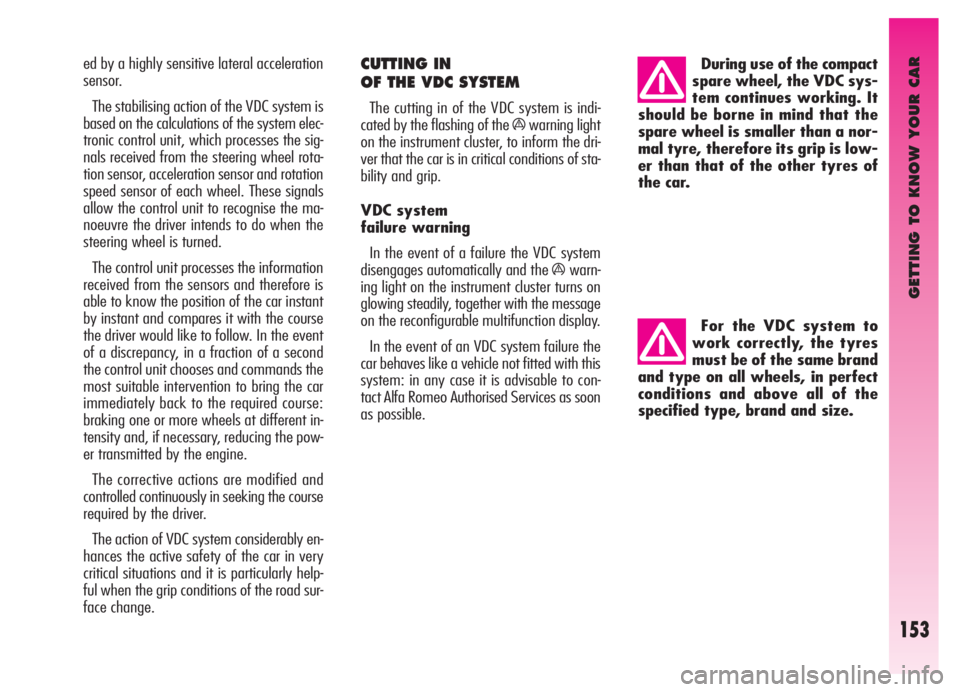
GETTING TO KNOW YOUR CAR
153
ed by a highly sensitive lateral acceleration
sensor.
The stabilising action of the VDC system is
based on the calculations of the system elec-
tronic control unit, which processes the sig-
nals received from the steering wheel rota-
tion sensor, acceleration sensor and rotation
speed sensor of each wheel. These signals
allow the control unit to recognise the ma-
noeuvre the driver intends to do when the
steering wheel is turned.
The control unit processes the information
received from the sensors and therefore is
able to know the position of the car instant
by instant and compares it with the course
the driver would like to follow. In the event
of a discrepancy, in a fraction of a second
the control unit chooses and commands the
most suitable intervention to bring the car
immediately back to the required course:
braking one or more wheels at different in-
tensity and, if necessary, reducing the pow-
er transmitted by the engine.
The corrective actions are modified and
controlled continuously in seeking the course
required by the driver.
The action of VDC system considerably en-
hances the active safety of the car in very
critical situations and it is particularly help-
ful when the grip conditions of the road sur-
face change.For the VDC system to
work correctly, the tyres
must be of the same brand
and type on all wheels, in perfect
conditions and above all of the
specified type, brand and size.CUTTING IN
OF THE VDC SYSTEM
The cutting in of the VDC system is indi-
cated by the flashing of the
áwarning light
on the instrument cluster, to inform the dri-
ver that the car is in critical conditions of sta-
bility and grip.
VDC system
failure warning
In the event of a failure the VDC system
disengages automatically and the
áwarn-
ing light on the instrument cluster turns on
glowing steadily, together with the message
on the reconfigurable multifunction display.
In the event of an VDC system failure the
car behaves like a vehicle not fitted with this
system: in any case it is advisable to con-
tact Alfa Romeo Authorised Services as soon
as possible.During use of the compact
spare wheel, the VDC sys-
tem continues working. It
should be borne in mind that the
spare wheel is smaller than a nor-
mal tyre, therefore its grip is low-
er than that of the other tyres of
the car.
Page 157 of 307
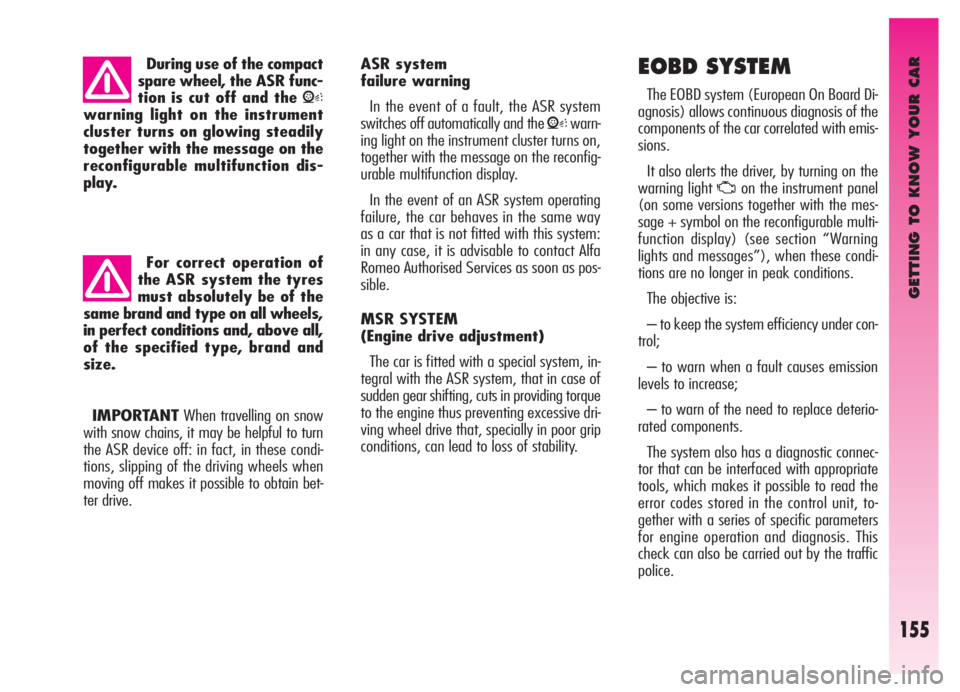
GETTING TO KNOW YOUR CAR
155
ASR system
failure warning
In the event of a fault, the ASR system
switches off automatically and the
Vwarn-
ing light on the instrument cluster turns on,
together with the message on the reconfig-
urable multifunction display.
In the event of an ASR system operating
failure, the car behaves in the same way
as a car that is not fitted with this system:
in any case, it is advisable to contact Alfa
Romeo Authorised Services as soon as pos-
sible.
MSR SYSTEM
(Engine drive adjustment)
The car is fitted with a special system, in-
tegral with the ASR system, that in case of
sudden gear shifting, cuts in providing torque
to the engine thus preventing excessive dri-
ving wheel drive that, specially in poor grip
conditions, can lead to loss of stability.
EOBD SYSTEM
The EOBD system (European On Board Di-
agnosis) allows continuous diagnosis of the
components of the car correlated with emis-
sions.
It also alerts the driver, by turning on the
warning light
Uon the instrument panel
(on some versions together with the mes-
sage + symbol on the reconfigurable multi-
function display) (see section “Warning
lights and messages”), when these condi-
tions are no longer in peak conditions.
The objective is:
– to keep the system efficiency under con-
trol;
– to warn when a fault causes emission
levels to increase;
– to warn of the need to replace deterio-
rated components.
The system also has a diagnostic connec-
tor that can be interfaced with appropriate
tools, which makes it possible to read the
error codes stored in the control unit, to-
gether with a series of specific parameters
for engine operation and diagnosis. This
check can also be carried out by the traffic
police. During use of the compact
spare wheel, the ASR func-
tion is cut off and the
V
warning light on the instrument
cluster turns on glowing steadily
together with the message on the
reconfigurable multifunction dis-
play.
For correct operation of
the ASR system the tyres
must absolutely be of the
same brand and type on all wheels,
in perfect conditions and, above all,
of the specified type, brand and
size.
IMPORTANTWhen travelling on snow
with snow chains, it may be helpful to turn
the ASR device off: in fact, in these condi-
tions, slipping of the driving wheels when
moving off makes it possible to obtain bet-
ter drive.
Page 158 of 307

GETTING TO KNOW YOUR CAR
156
IMPORTANTAfter eliminating the in-
convenience, to check the system com-
pletely, Alfa Romeo Authorised Services are
obliged to run a bench test and, if necessary,
road tests which may also call for a long jour-
ney.
INTRODUCTION
The radio is fitted with CD player (radio
with Compact Disc player) or CD MP3 play-
er (radio with Compact Disc MP3 player)
and has been designed in accordance with
the specific features of the passenger com-
partment, with a personalised design that
blends with the style of the dashboard. The
radio dimensions are suitable for the car and
as it is of fixed type it cannot be installed on
any other vehicle.
The instructions for use also include how
to control the CD Changer (if fitted) through
the radio. For the instructions for use of the
CD Changer, refer to the specific manual.
ADVICE
Too high a volume when
driving can put the drivers
life at risk and that of oth-
er people. Therefore the volume
should always be adjusted in such
a way that it is always possible to
hear the noises of the surrounding
environment (e.g. horns, ambu-
lance, police sirens, etc.).
Road safety
You are advised to learn how to use the
various radio functions (e.g. storing stations)
before starting to drive.
Reception conditions
The reception conditions change constant-
ly when travelling. Reception may be dis-
turbed by the presence of mountains, build-
ings or bridges in particular if far away from
the broadcasting transmitter. If, turning the ignition key
to MAR, the warning light
Udoes not turn on or if,
while travelling it turns on glow-
ing steadily or flashing (on some
versions together with the mes-
sage + symbol on the reconfig-
urable multifunction display), con-
tact Alfa Romeo Authorised Ser-
vices as soon as possible.
RADIO WITH COMPACT DISC PLAYER
(Upon request for versions/markets where applicable)
Page 161 of 307

GETTING TO KNOW YOUR CAR
159
PROTECTION AGAINST THEFT
The radio is fitted with an antitheft pro-
tection system based on the exchange of in-
formation between the radio and the elec-
tronic control unit (Body Computer) installed
on the car. This system warrants the high-
est level of security and prevents entry of
the secret code every time the radio sup-
ply is disconnected.
After every re-connection an automatic
check procedure is performed during which
the display shows the wording “CAN-
CHECK” for about one second. If the result
of the check is positive, the set starts work-
ing, whereas if the comparison codes are
not the same or if the radio is connected for
the first time to the vehicle electric system,
the device informs the user of the need to
enter the secret code according to the pro-
cedure described in the following paragraph.
During the code entry procedure the dis-
play shows the word “CODE”. The set will
not work until the correct code is entered.
This way the protection system makes the
radio unusable after removal from the dash-
board in the case of theft. On multimedia CDs in ad-
dition to sound tracks also
data tracks are recorded.
Playing one of these CDs may cause
rustling at such a volume as to com-
promise road safety, as well as
causing damage to the final stages
and speakers.
Sound section
– Pause function
– Loudness function (excluding versions
with HI-FI BOSE sound system)
– 7 band graphic equaliser
– Separate bass/treble adjustment
– Right/left and front/rear channel bal-
ancing.
CAUTIONS
If it is very cold inside the car and the CD
player is used a little after turning the heater
on, a film of damp may form on the Com-
pact Disc or on the player optics and the
sound may not be perfect. In this case do
not use the CD player for at least an hour,
so that the condensation dissolves natural-
ly and normal operation is resumed.
Driving on rough roads with heavy vibra-
tions may cause skipping when the CD play-
er is working.
Page 162 of 307
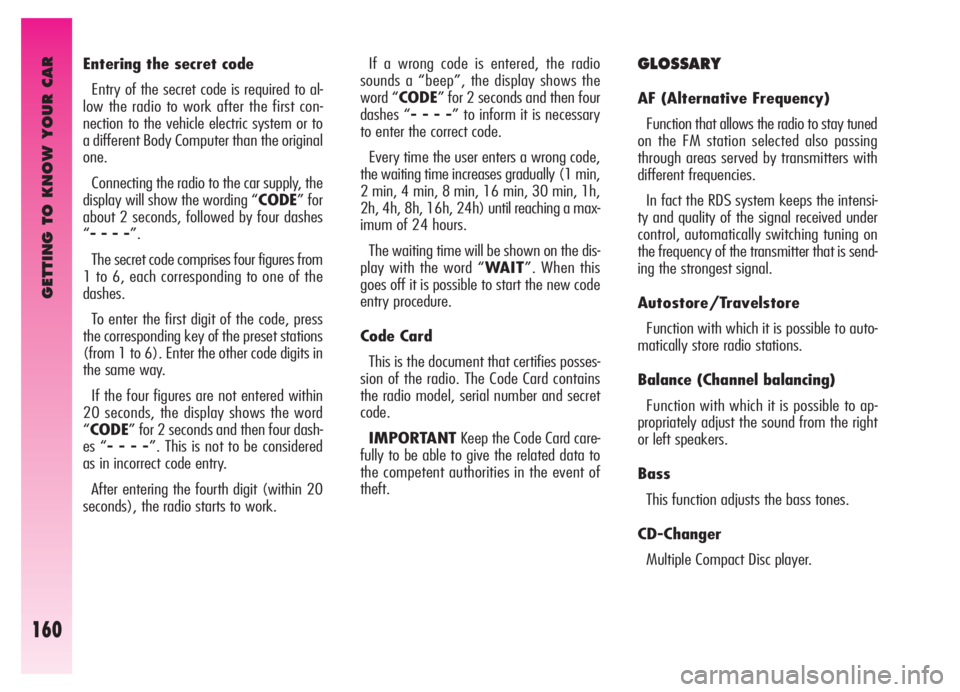
GETTING TO KNOW YOUR CAR
160
Entering the secret code
Entry of the secret code is required to al-
low the radio to work after the first con-
nection to the vehicle electric system or to
a different Body Computer than the original
one.
Connecting the radio to the car supply, the
display will show the wording “CODE” for
about 2 seconds, followed by four dashes
“- - - -”.
The secret code comprises four figures from
1 to 6, each corresponding to one of the
dashes.
To enter the first digit of the code, press
the corresponding key of the preset stations
(from 1 to 6). Enter the other code digits in
the same way.
If the four figures are not entered within
20 seconds, the display shows the word
“CODE” for 2 seconds and then four dash-
es “- - - -”. This is not to be considered
as in incorrect code entry.
After entering the fourth digit (within 20
seconds), the radio starts to work.If a wrong code is entered, the radio
sounds a “beep”, the display shows the
word “CODE” for 2 seconds and then four
dashes “- - - -” to inform it is necessary
to enter the correct code.
Every time the user enters a wrong code,
the waiting time increases gradually (1 min,
2 min, 4 min, 8 min, 16 min, 30 min, 1h,
2h, 4h, 8h, 16h, 24h) until reaching a max-
imum of 24 hours.
The waiting time will be shown on the dis-
play with the word “WAIT”. When this
goes off it is possible to start the new code
entry procedure.
Code Card
This is the document that certifies posses-
sion of the radio. The Code Card contains
the radio model, serial number and secret
code.
IMPORTANTKeep the Code Card care-
fully to be able to give the related data to
the competent authorities in the event of
theft.GLOSSARY
AF (Alternative Frequency)
Function that allows the radio to stay tuned
on the FM station selected also passing
through areas served by transmitters with
different frequencies.
In fact the RDS system keeps the intensi-
ty and quality of the signal received under
control, automatically switching tuning on
the frequency of the transmitter that is send-
ing the strongest signal.
Autostore/Travelstore
Function with which it is possible to auto-
matically store radio stations.
Balance (Channel balancing)
Function with which it is possible to ap-
propriately adjust the sound from the right
or left speakers.
Bass
This function adjusts the bass tones.
CD-Changer
Multiple Compact Disc player.
Page 165 of 307

GETTING TO KNOW YOUR CAR
163
CONTROLS ON FRONT PANEL
(fig. 154)
1. AF-TAFunction select button:
– AF (alternative frequen-
cies)
– TA (traffic information)
2. PTYFunction select button:
– RDS PTY (type of RDS pro-
gramme)
– Choice of the subject of
PTY transmission in EON
mode
3.Compact Disc slot4.
¯¯Selected Sound and Menu ad-
justment and manual station
search button
5.
˚Compact Disc eject button
6.
▲Sound and Menu select button
and automatic station search
7.
˙˙Selected Sound and Menu
function adjustment and man-
ual station search
8.
▼Sound and Menu select button
and automatic station search9. MENU-PSMenu and Scan function
button (hearing stored
stations in sequence)
10. 6Function select button:
– Call station no. 6
– Store station no. 6
6 MP3
|(only if car radio with
reader MP3 is present)
Function selection key:
– Calling station no. 6
– Storing station no. 6
– Displaying folders/pieces
in format MP3
fig. 154A0A0230b
Page 168 of 307
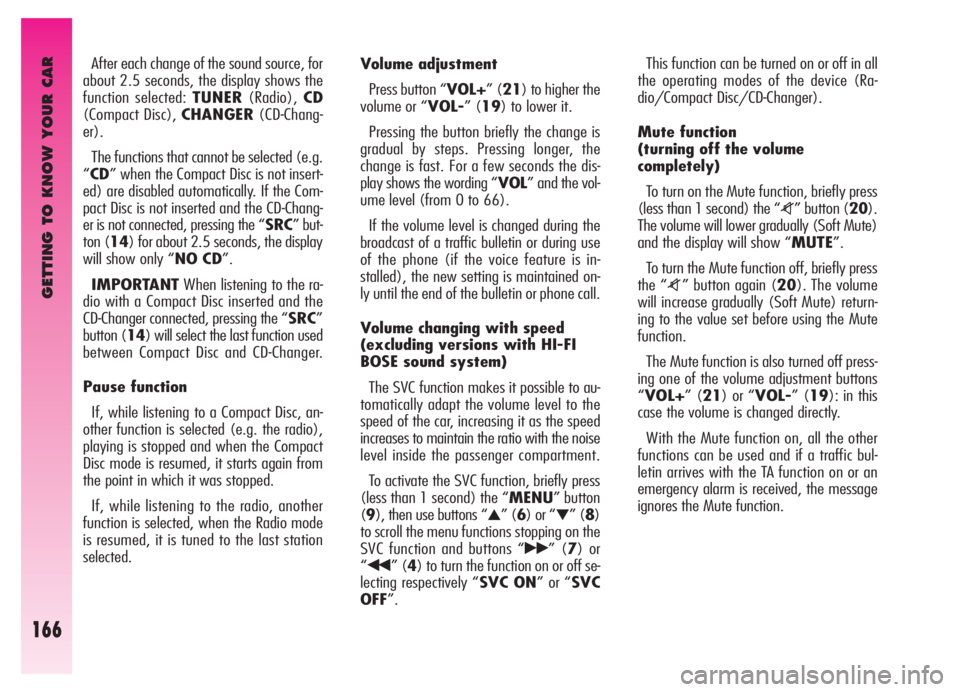
GETTING TO KNOW YOUR CAR
166
After each change of the sound source, for
about 2.5 seconds, the display shows the
function selected: TUNER(Radio),CD
(Compact Disc), CHANGER(CD-Chang-
er).
The functions that cannot be selected (e.g.
“CD” when the Compact Disc is not insert-
ed) are disabled automatically. If the Com-
pact Disc is not inserted and the CD-Chang-
er is not connected, pressing the “SRC” but-
ton (14) for about 2.5 seconds, the display
will show only “NO CD”.
IMPORTANTWhen listening to the ra-
dio with a Compact Disc inserted and the
CD-Changer connected, pressing the “SRC”
button (14) will select the last function used
between Compact Disc and CD-Changer.
Pause function
If, while listening to a Compact Disc, an-
other function is selected (e.g. the radio),
playing is stopped and when the Compact
Disc mode is resumed, it starts again from
the point in which it was stopped.
If, while listening to the radio, another
function is selected, when the Radio mode
is resumed, it is tuned to the last station
selected.Volume adjustment
Press button “VOL+” (21) to higher the
volume or “VOL-” (19) to lower it.
Pressing the button briefly the change is
gradual by steps. Pressing longer, the
change is fast. For a few seconds the dis-
play shows the wording “VOL” and the vol-
ume level (from 0 to 66).
If the volume level is changed during the
broadcast of a traffic bulletin or during use
of the phone (if the voice feature is in-
stalled), the new setting is maintained on-
ly until the end of the bulletin or phone call.
Volume changing with speed
(excluding versions with HI-FI
BOSE sound system)
The SVC function makes it possible to au-
tomatically adapt the volume level to the
speed of the car, increasing it as the speed
increases to maintain the ratio with the noise
level inside the passenger compartment.
To activate the SVC function, briefly press
(less than 1 second) the “MENU” button
(9), then use buttons “
▲” (6) or “▼” (8)
to scroll the menu functions stopping on the
SVC function and buttons “
˙˙” (7) or
“
¯¯” (4) to turn the function on or off se-
lecting respectively “SVC ON” or “SVC
OFF”.This function can be turned on or off in all
the operating modes of the device (Ra-
dio/Compact Disc/CD-Changer).
Mute function
(turning off the volume
completely)
To turn on the Mute function, briefly press
(less than 1 second) the “
z” button (20).
The volume will lower gradually (Soft Mute)
and the display will show “MUTE”.
To turn the Mute function off, briefly press
the “
z” button again (20). The volume
will increase gradually (Soft Mute) return-
ing to the value set before using the Mute
function.
The Mute function is also turned off press-
ing one of the volume adjustment buttons
“VOL+” (21) or “VOL-” (19): in this
case the volume is changed directly.
With the Mute function on, all the other
functions can be used and if a traffic bul-
letin arrives with the TA function on or an
emergency alarm is received, the message
ignores the Mute function.